I bought a turkey yesterday for Thursday’s Thanksgiving food orgy – 15 pounds at $0.68 per pound at Dillions supermarket in Manhattan (Kansas).
We usually don’t go anywhere because the town is more serene with the students gone, and we host a dinner for various international stragglers with nowhere else to go.
 At least I didn’t have to go to Whole Foods. Terrible food safety and so insufferable.
At least I didn’t have to go to Whole Foods. Terrible food safety and so insufferable.
For the past couple of weeks, Whole Foods has been pushing their turkeys like some form of food porn crack, and repeating the following statements as mantra:
“No antibiotics — ever
No supplemental growth hormones*
No animal byproducts in feed
“*Federal regulations prohibit the use of hormones when raising poultry”
Whole Foods lets birds suffer if they are sick, and follows the law by not using hormones. Should sick animals be deprived antibiotics? Wouldn’t that go against animal welfare standards? I don’t see how this is the basis for an advertizing campaign. Federal regulators may want to have a look, seeing as they cracked down on Tyson’s BS claims that they didn’t use antibiotics in poultry production that no one else used.
Whole Foods does have a bunch of homespun tales about turkeys raised by farmers the way our grandparents did it. Apparently society has learned nothing about food production over the past 60 years.
Whole Foods also has a thing against modern technology like freezing, and says it only sells fresh birds – big cross-contamination problem
I bought fresh birds a couple of times in the 1990s, and concluded they were overpriced and sucked. Same with fresh pasta. Some things are meant to be preserved using technology.
But this marketing is aimed directly at the consumers’ pocketbook.
“It just makes sense that the more care and time that goes into raising the turkeys, the more they will cost.”
Good for you if people will pay.
The Chicago Tribune reports that Whole Foods is also piloting a new humane meat-rating system in the South and scheduled for national expansion early next year. If the six-step, color-coded labeling system works as planned, it could allow .jpg) American consumers at many supermarket chains unprecedented levels of specificity when it comes to choosing meat to match their principles.
American consumers at many supermarket chains unprecedented levels of specificity when it comes to choosing meat to match their principles.
I’d really like to be able to choose meat and other foods by levels of microbial contamination. American retailers will market anything to make a buck, but why not reward those producers, processors and retailers who consistently deliver food that doesn’t make people barf.
“Developed by the Global Animal Partnership, a nonprofit group made up of farmers, scientists, retailers, sustainability experts and animal welfare advocates, the rating system aims to address growing consumer concerns over the way animals are raised for food. It could also, not coincidentally, boost sales for certified farmers and participating stores, likely to include another unidentified major national retailer and restaurant group in the coming year, according to the nonprofit.
“Its six-step approach establishes baseline standards for all meat sold in the store, while offering producers an opportunity to achieve higher ratings as their animal welfare standards improve based on the program’s benchmarks.
“So, for example, the highest rating (5+, colored green) would go to a chicken that, among other things, had been bred, hatched and raised on a single farm, .jpg) lived year-round on pasture covered with at least 75 percent vegetation and had legs that were healthy enough to support it by the time it reached market weight.
lived year-round on pasture covered with at least 75 percent vegetation and had legs that were healthy enough to support it by the time it reached market weight.
“And the lowest rating (1, colored yellow) would reflect adherence to several dozen baseline provisions about feed, antibiotics and treatment, but also a provision that the animal must not have been caged or crowded.”
The Whole Foods folks could have learned something from those studying restaurant inspection disclosure and the use of colors or grading schemes. I also expect absolutely no verification that the system communicates to shoppers what was intended.
"We get an enormous amount of questions from customers who want to know everything about the meat and animals, really detailed questions," said Anne Malleau, global animal production and welfare coordinator for Whole Foods Market. But the program is also aimed at customers who don’t want the gory details so much as assurances that their "food has been humanely produced," Malleau said.
Although the company has no set formula for pricing GAP levels, it did share some examples from an Atlanta-area store that started rolling out the program in 2009. Grain-fed rib-eye steak rated a Step 1 costs $14.99 lb., while local grass-fed  rib-eye, rated Step 4, costs $15.99 lb. And Canadian bone-in pork chops rated Step 1 cost $6.99 lb., while local bone-in pork chops rated Step 4 cost $7.99 lb.
rib-eye, rated Step 4, costs $15.99 lb. And Canadian bone-in pork chops rated Step 1 cost $6.99 lb., while local bone-in pork chops rated Step 4 cost $7.99 lb.
Who pays that? And relying on auditors? You have heard of Peanut Corporation of America and DeCoster eggs and dozens of other outbreaks. Anne, who used to go to the University of Guelph and even hang out with the folks in my lab (above, right, exactly as shown) I want microbiologically safe food. That’s something I’d pay for.
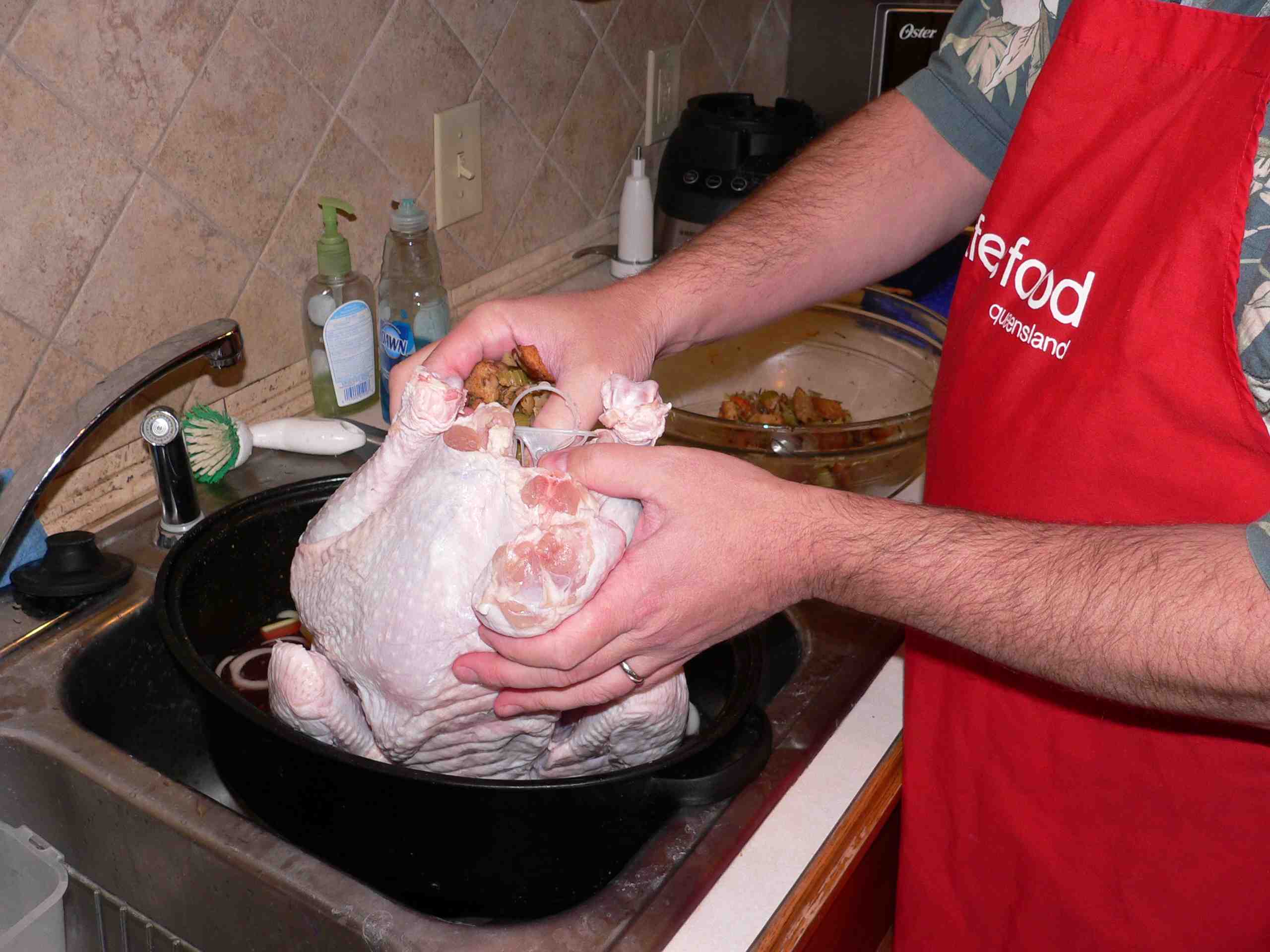 use Google searches to find various recipes (my students, tiring of me asking to find this or that, finally showed me how to use Google about four years ago), and then I improvise, generally adding more vegetables.
use Google searches to find various recipes (my students, tiring of me asking to find this or that, finally showed me how to use Google about four years ago), and then I improvise, generally adding more vegetables.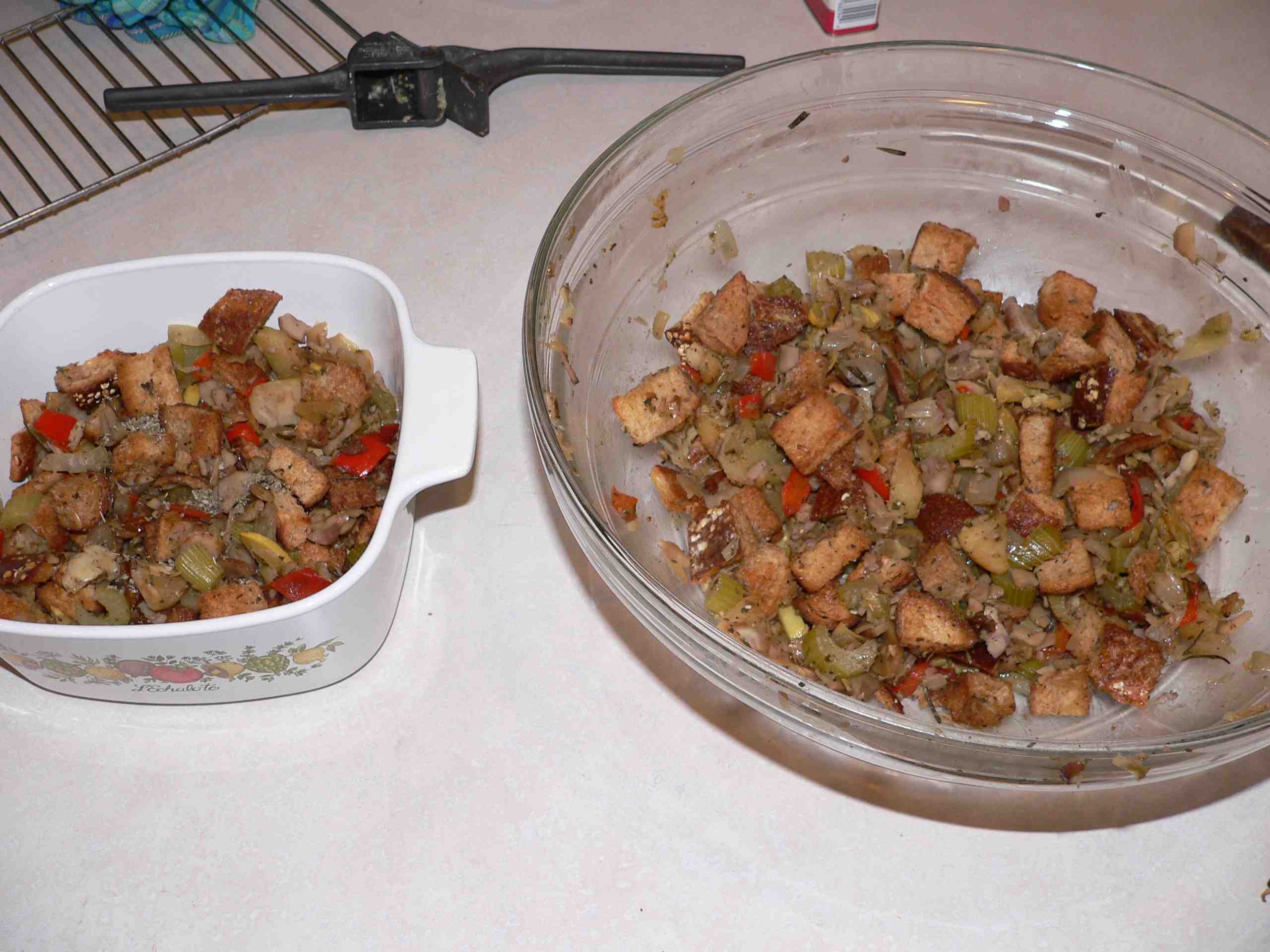 in the roasting pan to limit bug flow in the kitchen. Being prepped and having everything near the sink helps. Be the bug.
in the roasting pan to limit bug flow in the kitchen. Being prepped and having everything near the sink helps. Be the bug.
 47F and an interior temperature of 39F (I’ve been letting it sit on the counter to warm up in preparation for cooking).
47F and an interior temperature of 39F (I’ve been letting it sit on the counter to warm up in preparation for cooking).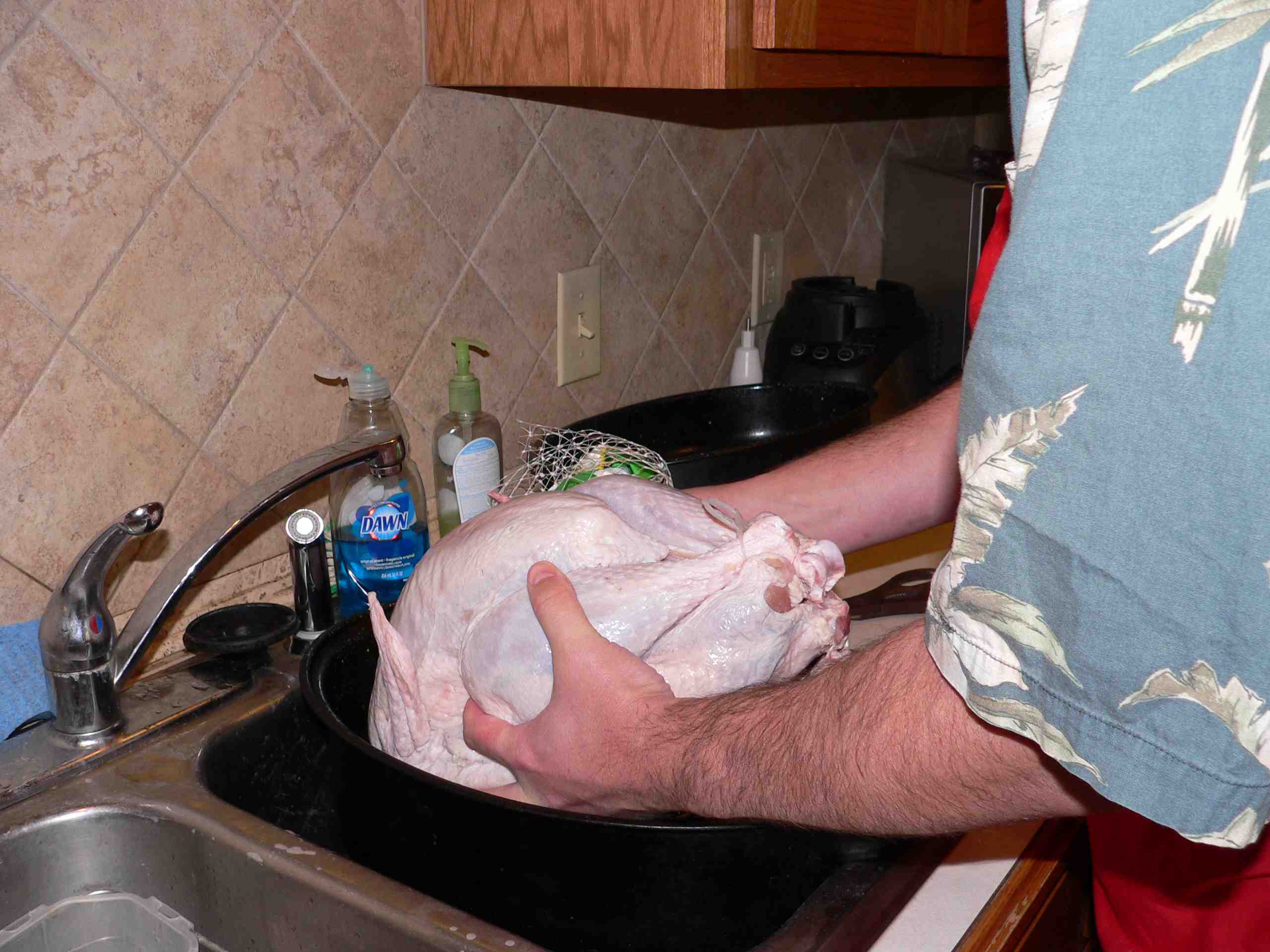 was a package of gravy mix in the cavity, covered in all sorts of bacteria. Got that into its own container, and the neck into the stock pot. Got me and the surrounding area cleaned up.
was a package of gravy mix in the cavity, covered in all sorts of bacteria. Got that into its own container, and the neck into the stock pot. Got me and the surrounding area cleaned up.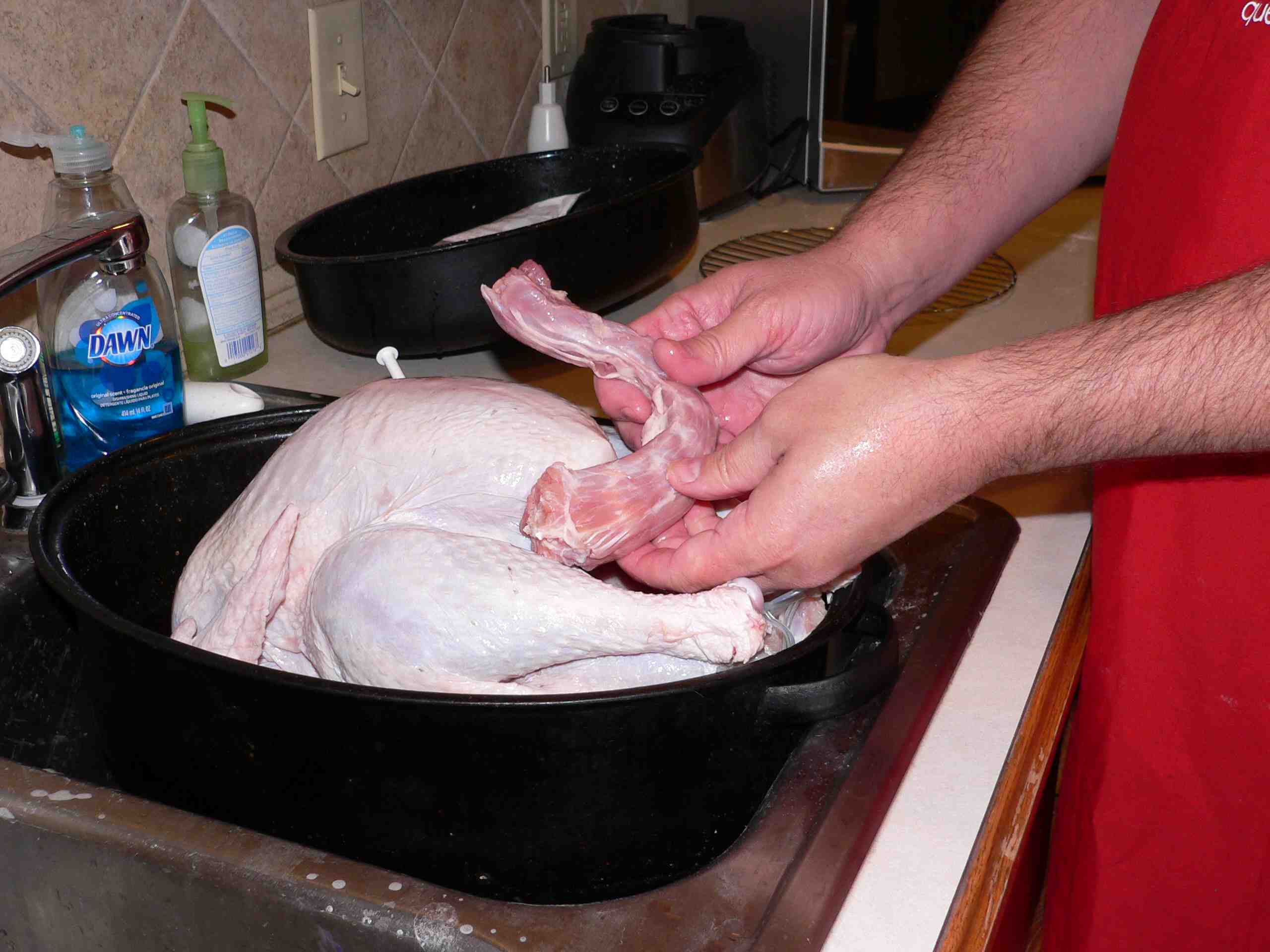

 raw on the inside and burnt on the outside—looked okay to us. That meal was scarfed down by a group of very hungry – and very poor – college students. We knew nothing of food safety, and probably didn’t care.
raw on the inside and burnt on the outside—looked okay to us. That meal was scarfed down by a group of very hungry – and very poor – college students. We knew nothing of food safety, and probably didn’t care. Here’s what I found:
Here’s what I found: at the Butterball Turkey Talk line explained. The placement of a pop-up timer is usually mechanical. This mechanical placement of the pop-up is temperamental – depending on the machines and the turkey placement (they’re slippery when raw!) — so breast, leg or other body parts may be pierced. Variations in the pop-up placement can affect pop-up timing, and presumed temperature. White meat (done at 165ºF-170ºF) cooks quicker than dark meat (where 180ºF is recommended). So instead of including a maybe-not-so-accurate thermometer, Butterball recommends using a probe thermometer to assure proper cooking. The U.S. Department of Agriculture’s meat and poultry hotline, and the Ask Karen online chat had similar information. A pop-up timer is calculated to pop when the breast meat measures about 180 degrees, which is when the leg and thigh area is most likely at the 165 degree temperature. Although pop-up timers are accurate to +/- 2ºF, they recommend verifying temperature of your bird with a thermometer that gives a numeric reading.
at the Butterball Turkey Talk line explained. The placement of a pop-up timer is usually mechanical. This mechanical placement of the pop-up is temperamental – depending on the machines and the turkey placement (they’re slippery when raw!) — so breast, leg or other body parts may be pierced. Variations in the pop-up placement can affect pop-up timing, and presumed temperature. White meat (done at 165ºF-170ºF) cooks quicker than dark meat (where 180ºF is recommended). So instead of including a maybe-not-so-accurate thermometer, Butterball recommends using a probe thermometer to assure proper cooking. The U.S. Department of Agriculture’s meat and poultry hotline, and the Ask Karen online chat had similar information. A pop-up timer is calculated to pop when the breast meat measures about 180 degrees, which is when the leg and thigh area is most likely at the 165 degree temperature. Although pop-up timers are accurate to +/- 2ºF, they recommend verifying temperature of your bird with a thermometer that gives a numeric reading..jpg) awareness, but nothing beats proper use of an appropriate numeric thermometer, and clear, accurate cooking instructions. It would have been safer to have an overcooked entrée masked with gravy, then the food safety disaster I fed to my friends. Thankfully, they survived.
awareness, but nothing beats proper use of an appropriate numeric thermometer, and clear, accurate cooking instructions. It would have been safer to have an overcooked entrée masked with gravy, then the food safety disaster I fed to my friends. Thankfully, they survived. year. In Thanksgivings past, socializing meant gathering with friends, family, loved ones and straggler students to share good food and good times. These days, being social around the holiday dinner table also takes on the meaning of regularly corresponding to all and sundry (a.k.a. our extended friends) about the food, the people, the football game, and the current goings on.
year. In Thanksgivings past, socializing meant gathering with friends, family, loved ones and straggler students to share good food and good times. These days, being social around the holiday dinner table also takes on the meaning of regularly corresponding to all and sundry (a.k.a. our extended friends) about the food, the people, the football game, and the current goings on. pound, it was a protein centerpiece bargain.
pound, it was a protein centerpiece bargain. Depending on where you live, a garage can work equally well for a long, slow thaw.
Depending on where you live, a garage can work equally well for a long, slow thaw..jpg) Department of Agriculture and the cooperation of the Sacred Heart Catholic Church in Arkansas City, have been conducting an investigation of a foodborne illness outbreak associated with the Sacred Heart Turkey Dinner that was held on the evening of November 8.
Department of Agriculture and the cooperation of the Sacred Heart Catholic Church in Arkansas City, have been conducting an investigation of a foodborne illness outbreak associated with the Sacred Heart Turkey Dinner that was held on the evening of November 8. .jpg) no more than two hours of taking the turkey out of the oven, adding,
no more than two hours of taking the turkey out of the oven, adding,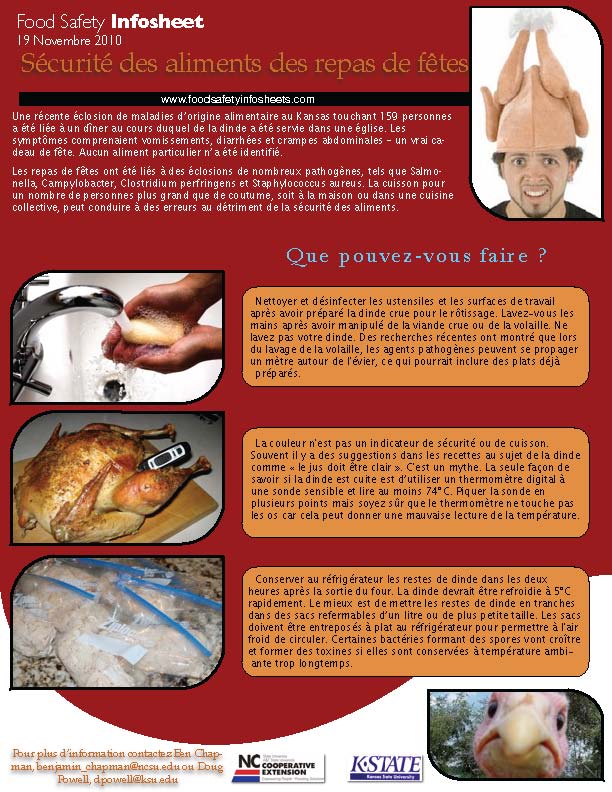 personnes plus grand que de coutume, soit à la maison ou dans une cuisine collective, peut conduire à des erreurs au détriment de la sécurité des aliments.
personnes plus grand que de coutume, soit à la maison ou dans une cuisine collective, peut conduire à des erreurs au détriment de la sécurité des aliments..jpg) American consumers at many supermarket chains unprecedented levels of specificity when it comes to choosing meat to match their principles.
American consumers at many supermarket chains unprecedented levels of specificity when it comes to choosing meat to match their principles..jpg) lived year-round on pasture covered with at least 75 percent vegetation and had legs that were healthy enough to support it by the time it reached market weight.
lived year-round on pasture covered with at least 75 percent vegetation and had legs that were healthy enough to support it by the time it reached market weight.  lavadero, y contaminar alimentos listos para comer que estén a dicha distancia.
lavadero, y contaminar alimentos listos para comer que estén a dicha distancia.